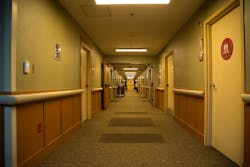DOE’s PNNL reports on tunable SSL research at senior nursing center
The Pacific Northwest National Laboratory (PNNL) has published a research report on a US Department of Energy (DOE)-funded study on the effects of tunable lighting on elderly patients residing in a nursing center. The study titled “Measuring Light Exposure and its Effects on Sleep and Behavior in Care Center Residents” revealed that sleep patterns generally improved for residents exposed to the tunable lighting with spectral power distribution (SPD) and output levels programmatically controlled. The lighting for health and wellbeing research took place at the 99-bed ACC Care Center in Sacramento, CA.
We first wrote about the ACC Care Center back in 2016 when the facility first installed some tunable solid-state lighting (SSL). A three-month research program at the time suggested that the programmatically-controlled LED lighting resulted in less agitated behavior among the patients, many of whom suffer some level of dementia.
That first ACC Care Center project only installed LED luminaires in select locations. In 2018, the facility installed tunable SSL in all of the corridors along which the patient rooms are located. The luminaires used are PlanLED Beetle luminaires manufactured by Samjin. PlanLED has been involved with a number of human-centric lighting projects including in Major League Baseball (MLB) locker rooms. In the care facility, the troffer-style SSL products replaced fluorescent fixtures on a one-for-one basis. PlanLED utilized the Samjin VLTRA Smart Technology platform to control and program the lighting.
The research team was larger and more diverse compared to the 2016 work at the care center. The team included three primary constituencies:
- Lighting and environmental design and measurement
- Experts in characterizing resident behavior outcomes
- Leaders from nursing centers with prior tunable lighting experience
The team notably included a number of participants from the Brown University School of Public Health.
Going into the project, the team surmised that the greatest impact of the tunable corridor lighting would be at night. The residents sleep in rooms directly connected to the corridors and generally with doors open so that staff can easily monitor the residents. Previously, the fluorescent lighting would spill into the rooms, although center staff had developed a practice of turning power off to half of the luminaires in each corridor during the night.
The new SSL installation was utilized to implement both the control and intervention scenarios. A setting with a CCT of 4100K was considered equivalent to the prior fluorescent lighting. In the control scenario, the 4100K lights were dimmed to 50% output at night to simulate turning half of the corridor lights off.
The intervention scenario included three settings. The nighttime setting was assumed to be the most important with CCT tuned to 2700K and light levels set at 21% of maximum. In the morning, the lights were tuned to 6500K and 100% output and remained at the setting until an evening transition period where the lights were set to 4100K and 100% output.
All of the corridors could be set for the control or intervention scenarios. The researchers rotated the corridor where the intervention scenario was being tested, so over the period of the program, all of the residents experienced both scenarios.
The intervention was associated with a significant decrease in sleep disturbances among the residents. Such disturbance are difficult to measure accurately, but the results would indicate that the tunable lighting would positively impact 5–7% of the residents and that in turn would have a trickle-down positive impact on roommates and care center staff. The test did not show a significant decrease in agitated behavior.
Ultimately, however, the most valuable results from the PNNL project may be the lighting data gathered. The researchers took measurements at 42-in. height from the floor, assuming that level to be typical eye height for a patient in a wheelchair. The team captured melanopic/photopic ratios, Circadian Stimulus (CS) values, and Equivalent Melanopic Lux (EML) values throughout the facility. For background on these metrics, see our coverage from our Lighting for Health and Wellbeing conference.
By gathering actual data in many of the sleeping rooms and all common areas, the research team can further mine the data. Those measurements, for example, capture instances of a resident having their own table light powered on a night or the use of a TV at night.
You can peruse the full report, on the DOE website, in PDF form.

Maury Wright | Editor in Chief
Maury Wright is an electronics engineer turned technology journalist, who has focused specifically on the LED & Lighting industry for the past decade. Wright first wrote for LEDs Magazine as a contractor in 2010, and took over as Editor-in-Chief in 2012. He has broad experience in technology areas ranging from microprocessors to digital media to wireless networks that he gained over 30 years in the trade press. Wright has experience running global editorial operations, such as during his tenure as worldwide editorial director of EDN Magazine, and has been instrumental in launching publication websites going back to the earliest days of the Internet. Wright has won numerous industry awards, including multiple ASBPE national awards for B2B journalism excellence, and has received finalist recognition for LEDs Magazine in the FOLIO Eddie Awards. He received a BS in electrical engineering from Auburn University.




![The DesignLights Consortium continues to make progress in shifting outdoor lighting products and implementation practices toward a more restrained and thoughtful strategy. [Image does not represent a DLC qualified fixture.] The DesignLights Consortium continues to make progress in shifting outdoor lighting products and implementation practices toward a more restrained and thoughtful strategy. [Image does not represent a DLC qualified fixture.]](https://img.ledsmagazine.com/files/base/ebm/leds/image/2024/08/66be810888ae93f656446f61-dreamstime_m_265700653.png?auto=format,compress&fit=&q=45&h=139&height=139&w=250&width=250)
